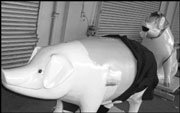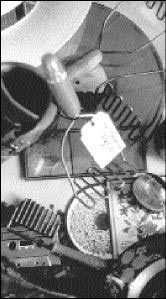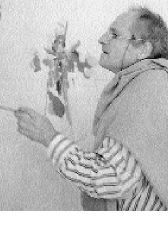WHEN ALL THOSE shiny fiberglass pigs rolled up Pike Street in the Pigs On Parade procession last month, they didn’t know they were being led to the slaughter. Lambasted by champions of that sacred icon, the starving artist, the pigs have fallen prey to far more vandalism than the Market Foundation anticipated. Perhaps this fate is ironically befitting to pigs panhandling for food and social programs for Seattle’s homeless, but, whether you’re pro- or anti-pig, it’s discouraging to see monies meant for charity being sucked up by continual repairs.
Basing figures on Chicago’s cow parade, the Foundation budgeted $100 per pig to cover repairs. At the rate things are currently going, though, each pig will require $300 worth over the course of the summer. Market Foundation director Marlys Erickson laments, “Every $100 amounts to [hundreds of grocery items] that won’t be given away.”
This is the worst part of Pigs on Parade: The most common graffiti mark on the oinkers has been the swastika, and that needless abuse is subtracting dollars from the charity. You’d think that, in a city so recently plagued by riots and police conflicts, we’d revel in the fact that the pigs aren’t wearing riot gear and leave them alone. Despite being slightly exasperated by negative press and the physical damage to the pigs, however, Erickson remains optimistic. Although a few pigs seem to have been mauled with blunt instruments and many have been subjected to graffiti, she’s convinced that most of the harm isn’t malicious, attributing broken parts and missing pieces to curiosity gone awry.
Most would agree that even pigs spruced up by the region’s best painters aren’t high-caliber artworks destined for prestigious museum collections but, rather, objects artfully decorated by artists (and others, including children). And while the pigs are benignly decorative and their sponsors are corporations, most of the participating artists actually don’t feel exploited. (Go to any blockbuster museum exhibition and you’ll see art that is stamped with approval from some corporate sponsor.) Some artists involved even expressed relief that a benefit solicited their time rather than one of their own works: Decorating a pig allowed them to have some fun in a medium and format utterly removed from their usual oeuvre. And it should bother all of us to see their work trashed.
I HAD NO DIFFICULTY finding artists ready to expound on the positive aspects of Pigs on Parade, yet, sadly, every last one I contacted reported damage to their pig. Geoff Garza is happy that pundits are going to bat to defend artists, but instead of feeling used, he’s delighted to see the Foundation’s profits soar beyond the $1,000 artist honorarium. “If the Market Foundation can get $20,000 for my pig, it couldn’t reflect better on me,” he says. He also applauds those fighting for challenging art but asserts that while “art can effect change, it can also simply change a person’s day.”
Similarly, artist Carol Milne notes that Pigs on Parade “may not build the art community, but it builds the larger community, bringing businesses and artists together with community groups. That was the point.”
Face it, the pigs are a big hit—with tourists, sure, but whether they’re scoffing at or delighting in the whimsy of the pigs, people are engaged in the spectacle, interacting with fellow citizens, making bad pig jokes, taking goofy photographs, and, most importantly, looking. Turns out these piggies—with not just a little help from their harshest critics—have incited a dynamic dialogue about art that is all too rare in this town.








